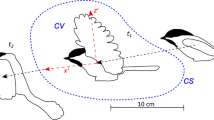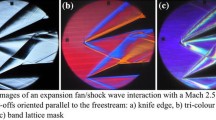Abstract
This article is concerned with describing and exploring the limitations of an improved version of a recently proposed visualization-based technique for the measurement of forces and moments in short-duration hypersonic wind tunnels. The technique is based on tracking the motion of a free-flying body over a sequence of high-speed visualizations; while this idea is not new in itself, the use of high-speed digital cinematography combined with a highly accurate least-squares tracking algorithm allows improved results over what have been previously possible with such techniques. The technique precision is estimated through the analysis of artificially constructed and experimental test images, and the resulting error in acceleration measurements is characterized. For wind-tunnel scale models, position measurements to within a few microns are shown to be readily attainable. Image data from two previous experimental studies in the T5 hypervelocity shock tunnel are then reanalyzed with the improved technique: the uncertainty in the mean drag acceleration is shown to be reduced to the order of the flow unsteadiness, 2–3%, and time-resolved acceleration measurements are also shown to be possible. The response time of the technique for the configurations studied is estimated to be ∼0.5 ms. Comparisons with computations using the DLR TAU code also yield agreement to within the overall experimental uncertainty. Measurement of the pitching moment for blunt geometries still appears challenging, however.

















Similar content being viewed by others
References
Bernstein L (1975) Force measurement in short-duration hypersonic facilities AGARDograph No. 214
Canning TN, Seiff A, James CS (1970) Ballistic-range technology. AGARDograph No. 138
Canny J (1986) A computational approach to edge detection. IEEE Trans Pattern Anal Mach Intell 8:679–714
Davis J-P, Sturtevant B (2001) Separation length in high-enthalpy shock/boundary layer interaction. Phys Fluids 12(10):2661–2687
Gander W, Golub GH, Strebel R (1994) Least-squares fitting of circles and ellipses. BIT 34:558–578
Hannemann V, Mack A (2008) Chemical non equilibrium model of the martian atmosphere. Proceedings of the 6th European symposium on aerothermodynamics for space vehicles, Versailles, France
Holden MS, Wadhams TP, MacLean M, Mundy E, Parker RA (2007) Experimental studies in LENS I and X to evaluate real gas effects on hypervelocity vehicle performance. AIAA Paper 2007–204
Horstman CC, Kussoy MI (1967) Free flight measurements of aerodynamic viscous effects on lifting re-entry bodies. J Spacecraft 4(8):1064–1069
Jain R, Kasturi R, Schunk BG (1995) Machine vision. McGraw-Hill, NY
Karl S (2008) CFD analysis of the hyshot II scramjet experiments in the HEG shock tunnel. 15th AIAA Int. space planes and hypersonic systems and technology conference, Apr. 2008, Dayton, OH, USA.
Laurence SJ (2006) Proximal bodies in hypersonic flow. Ph.D. thesis, California Institute of Technology
Laurence SJ, Hornung HG (2009) Image-based force measurement in hypersonic facilities. Exp Fluids 46:343–353
Laurence SJ, Deiterding R, Hornung HG (2007) Proximal bodies in hypersonic flow. J Fluid Mech 590:209–237
McIntosh MK (1969) A computer program of the numerical calculation of equilibrium and perfect gas conditions in shock tunnels. Australian Defense Scientific Service CPD 169
McIntyre T, Mallon M, Eichmann T (2008) High speed imaging of flow establishment and duration in impulse facilities. AIAA Paper 2008–4132
Mee DJ (2003) Dynamic calibration of force balances for impulse hypersonic facilities. Shock Waves 12(6):443-455
Meyer SL (1975) Data analysis for scientists and engineers. Wiley, New York
Robinson MJ, Mee DJ, Paull A (2006) Scramjet lift, thrust and pitching-moment characteristics measured in a shock tunnel. J Prop Power 22(1):85–95
Rockett P (1999) The accuracy of sub-pixel localisation in the Canny edge detector. Proceedings of the 10th British Machine Vision Conference, Nottingham, UK
Reimann B, Johnston I, Hannemann V (2004) The DLR TAU-code for high enthalpy flows. Notes on numerical fluid mechanics and multidisciplinary design, vol. 87, Springer, NY
Richards BE, Enkenhus KR (1970) Hypersonic testing in the VKI longshot free piston tunnel. AIAA J 8(6):1020–1025
Sanderson SR, Simmons JM (1991) Drag balance for hypervelocity impulse facilities. AIAA J 12:2185–2191
Settles GS (2006) Schlieren and shadowgraph techniques. Springer, NY
Spalart PR, Allmaras SR (1992) A one-equation turbulence model for aerodynamic flows. AIAA-Paper 92–0439
Tanno H, Itoh K, Saito K, Abe A, Takayama K (2004) Unsteady force measurement technique in shock tubes. Rev Sci Instrum 75(2):532–536
Tanno H, Kodera M, Komuro T, Sato K, Takahasi M, Itoh K (2005) Aerodynamic force measurement on a large-scale model in a short duration test facility. Rev Sci Instrum 76(3), article no. 035107
Warren WR, Kaegi EM, Geiger RE (1961) Shock tunnel experimental techniques for force and moment and surface flow direction measurements. ARS J 31(1):82–83
Acknowledgments
The authors would like to acknowledge fruitful discussions with Jan Martinez Schramm and Jeremy Wolfram; the primary author gratefully acknowledges the guidance of Prof. Hans Hornung, to whom, on the occasion of his 75th birthday, this manuscript is dedicated.
Author information
Authors and Affiliations
Corresponding author
Rights and permissions
About this article
Cite this article
Laurence, S.J., Karl, S. An improved visualization-based force-measurement technique for short-duration hypersonic facilities. Exp Fluids 48, 949–965 (2010). https://doi.org/10.1007/s00348-009-0780-9
Received:
Revised:
Accepted:
Published:
Issue Date:
DOI: https://doi.org/10.1007/s00348-009-0780-9




